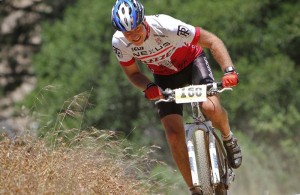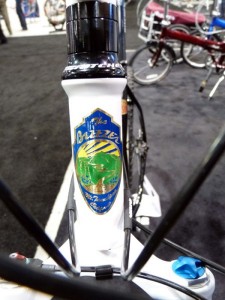[Note: Mountain biking legend Joe Breeze announced a few days ago that he was returning to his founding sport after a prescient and hugely successful line of commuter bikes over the past decade. Joe graciously agreed to expand on his back-to-the-future path in an email Q&A.]
The day after you stopped making mountain bikes, your fans began begging you to come back. Why now, given the shaky economy?
Back in 1998, it was a tough decision to not make mountain bikes. I made the choice because I felt it was time to focus on transportation bikes, which were virtually unknown in the US and extremely important for many reasons. With me as sole designer, spokesperson etc for Breezer, doing mountain bikes at the same time would have been too big a distraction. Now transportation bikes are an established and successful category, with Breezer being recognized as a leader. Since I teamed up with a much bigger company, Advanced Sports Inc. (late 2008), I’ve finally been able to re-enter the mountain bike field. We’re still focused on transportation bikes, but ASI also wanted to do Breezer mountain bikes and so did I. I don’t know exact demand/numbers, but the level of enthusiasm of the people who take time to find me and ask for mountain bikes has always been an encouragement. We chose to start with a hardtail because 1) people had been asking for an updated Breezer hardtail, 2) it was relatively easy to do, and 3) hardtails are still quite viable.
You talk about steel’s strength as a frame material and have gone with a curved downtube. How’s the process work?
Fork blades, chainstays and other tubes on frames are bent cold after the tube has been drawn. Breezer downtubes are hydro-formed, but structurally the result is essentially the same. The curved down tube is to allow clearance for the 100mm-travel fork. I could have continued the tube straight to the head tube without curving, but the tube would’ve intersected the head tube a long ways from its lower end. Without a gusset, that would’ve resulted in a weak structure. With a gusset, it would deaden the ride quality. A curved tube was the best solution.
”The lightest for their strength.” How lighter than ti, and how stronger?
I should have made it clear that I was speaking in the context of the bikes’ individual materials: steel (Lightning) and aluminum (Thunder). In each material, I work to make the lightest frame per strength. It is possible to build a titanium frame that’s lighter/stronger, but it’s a challenge. Unfortunately the gains with Ti are small or non-existent because Ti tubing and joinery is less sophisticated than the steel and aluminum counterparts, owing to titanium’s expense and difficulty to work with. Ti suffers from poor economy of scale.

These 2010 Breezer mountain bikes are made in Taiwan. It really is not economically feasible to make this product in the USA. You may recall that some time ago in the USA, bikes equated to about zip. Zip was unappealing to build. Zip was eagerly taken over by countries where people saw a future in it. They built it. The industry grew there and it is there. It’s nice that you see me as a game changer or a visionary, but change that?

The badge is etched and painted brass and attached with drive screws. I arrived at the design in 1982. It is similar to the badges on the 1930s and 40s Schwinns we once rode, as is the “spears and diamonds” paint job. The badge depicts Mt. Tam in my Marin County backyard. The road down the middle is Old Railroad Grade, remnant of the Mt. Tamalpais & Muir Woods Scenic Railway (1896-1930). This was the scene of my first fat-tire ride, in 1973. There are redwoods and blue lupine. The road in the foreground is Rollercoaster Ridge, and the tire is a Stumpjumper, the best tire of its day.
What can you say about the forthcoming 29ers?
In 2011, we will offer four hardtail 29ers, two in aluminum and two in carbon fiber. One priority has been to make them great climbers. [Note: See accompanying press release.]
Rather than sell your brand to Trek or a similar megacorporation back in the ’90s, you stuck with small and boutique. Assuming you’d agree it was the right choice, did it offer any advantages in the evolving marketplace?

What’s the biggest surprise to you about how the sport of mountain biking has evolved?
The biggest surprise to me came quite a few years back, and that is how big the sport became in Europe, or that it happened there at all — that an American product was embraced so fully. I had never felt that Europe needed anyone’s help regarding bikes.
What’s the most impressive innovation in cycling you’ve seen (that you didn’t do yourself)?
Indexed shifting.
Is your son faster than you? Or does dad still rool?!
As Tommy approached his teens I knew I’d need to get in better shape if I was going to ride with him for long. Last year he joined the Drake High School mountain bike team and became a top-10 Freshman in NorCal racing. I’ve stepped up my program, but increasingly he’s a speck on the horizon. I still give him a run for his money on the downhills though.

great interview! joe’s a very busy guy so great to see another recent interview with him, especially with the introduction of his 26″ and 29″ hardtails. keep up the good work, bike intelligencer. i like the insightful and balanced approach your website offers.
Great interview Paul. Thanks!
I learned something new!… the tire tread on the head badge is a Stumpjumper tire, i never knew that! It is so exciting to see Joe’s great ideas making bikes better all the time, both commuters (which are very fast and comfortable, BTW… my wife said “if my last bikes were this easy to ride, i would have ridden it much more!”) and his racer/sportsman bikes.
A note to Tommy, don’t feel bad about being skunked on the downhills. ‘Downhilling’ comes with experience, and the few times I have had a chance to ‘chase’ Joe, he has demonstrated an uncanny ability to find his way though the roughest downhills and fly around loose seemingly traction-less corners as effortlessly as the wind. I would say i ate dust, but Joe some how did not make any dust either, he just disappeared down the trail while i hung on for dear life. In my estimation that speed only comes from a calm ability to rely on experience and mental visualization.
We need to start bringing made in USA back home. I think Cannondale still makes bikes in USA. Why are you supporting foreign labor who pay their people nothing to live on and force long hours, etc.